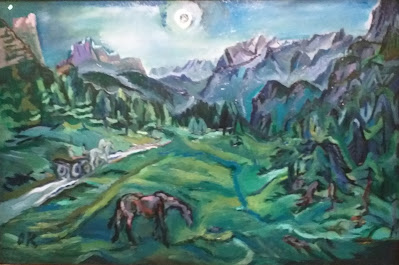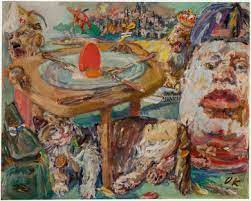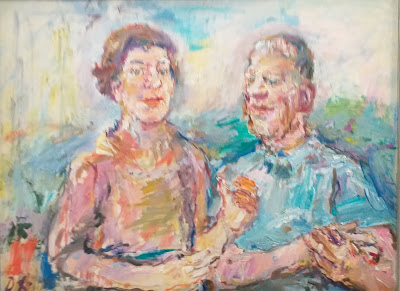 |
| Tigon (cross between lion and tiger) 1926 |
Oscar Kokoschka may have identified with this animal, painted in Regent's Park Zoo in London. Some of the artist's Viennese contemporaries called him the 'Oberwidling'- the 'savage'. The Exhibition at the Museum of Modern Art in Paris refers to him as a 'fauve' (wild beast). When it moves to the Guggenheim in Bilbao in March 2023, the title will change to 'enfant terrible'. Kokoschka expressed his wild side when he shaved off his hair in 1909 to look like a prisoner:
 |
| Young girl standing among vines 1908 lithography |
 |
| Boys who dream (Tröumenden Knöben) 1908 (colour lithography) |
Kokoschka was also a poet. The Bibliothèque Nationale in Paris has lent a copy of Kokoschka's poem about adolescent boys' awakening sexuality - a subject which shocked the Viennese public at the time. A year later his Expressionist drama called 'Murderer, the Hope of Women' caused further scandal. His crudeness was provocative.
Kokoschka is known primarily nowadays as an expressionistic portrait painter. As he himself said, when questioned about his expressionism: " I am expressionistic because I can't do anything else but express life."
 |
| Self portrait 1917 |
 |
| Dresden, Neustadt VII 1922 |
Oskar Kokoschka's view of Dresden is one of the 150 works on show at the Museum of Modern Art. He painted it in 1922, from his workshop at the Arts School overlooking the river Elbe. Kokoschka, like Cézanne before him, was concerned with translating depth and volume in blocks of colour, but using the bright colours usually associated with Die Brücke artists or Fauvism.
The exhibition contains several self portraits. From his colourful Dresden period:
 |
| Self portrait with arms crossed 1923 |
.jpg) |
| Portrait of Carl Moll 1913 |
Artist and collector, Carl Moll founded the Viennese Secession Movement in 1897, along with Gustav Klimt. Moll was married to composer Alma Mahler's mother. It was through him that Kokoschka met Alma. They became lovers. The portrait of Moll shows the influence of El Greco, whose works Kokoschka had seen and admired in Venice that year.
 |
| Portrait of Herwarth Walden 1910 |
Herwarth Walden was the founder of the avant garde magazine "Der Sturm" (the Storm). The magazine was a link between writers in Paris and Berlin before World War 1. Kokoschka lived in Walden's home for a time in Berlin. He saw Walden as the representative of modernity. A member of the Communist party, Walden went to Moscow in 1932 to avoid Nazism. Ironically, he died in a Soviet concentration camp in 1941, having been sent there because of his publishing activities. He was a tragic victim of the troubled times he lived through - the times which Kokoschka experienced and expressed.
Alma Mahler's portrait by Kokoschka featured on the front of Der Sturm in 1914:
 |
 |
| Alma Mahler 1913 Pencil on paper |
Kokoschka's portrait of his friends' father, below, did not spare his model, even showing his false teeth! Apparently Father Hirsch was an obstinate, rich, grumpy business man. Observers were scandalised by this portrait, which has a feeling of Van Gogh about it:
 |
| Portrait of Father Hirsch 1909 |
 |
| The Prisoner 1914 |
The hands sometimes form a communication between his sitters:
 |
| Hans and Erica Tietze 1909 |
This double portrait of art historians, admirers of Kokoschka's work, is normally in the MOMA, New York. It was ordered by the couple to celebrate their marriage. Erica described how Kokoschka daubed with his fingers and used his nails to scratch away paint.
 |
| Self portrait at the easel 1922 |
Here the artist is accompanied by a clay sculpture referring perhaps to the fetish doll which had previously kept him company until he destroyed it.
 |
| Photo of The Doll, seated 1919 |
The story of the doll is a curious one. Oskar had a turbulent affair with Alma Mahler and the couple broke up just before World War1. Oskar sold a painting of the two lovers in order to buy a horse and signed up with the Dragoons. Later he asked fellow artist Hermine Moos to create a doll representing Alma. Disappointed with it, or perhaps expressing his frustration with women, he destroyed it.
 |
| Painter with doll 1922 |
Several of Kokoschka's landscapes are included in the exhibition:
 |
| Landscape in the Dolomites 1913 |
Alma Mahler wrote of Oskar's frenzied search for new colours on their forest walks.
Painted during a stay in London, there is a view of the Thames in yellows and purples, from his window at the hotel Savoy, where Claude Monet had earlier resided:
 |
| London- little Thames landscape 1926 |
In the 30s, Kokoschka was inevitably included in the Nazi list of "Degenerate Artists" and his works were taken off the walls of German museums. Several were paraded around Europe, as an example of how not to paint! He was in the company of great artists such as Picasso, Chagall and Klimt.
When he knew that he figured in the degenerate art (Entartete Kunst) exhibition, Kokoschka defiantly, and humorously, did a self portrait "as a Degenerate Artist":
 |
| Self portrait as a degenerate artist 1937 |
 |
| Liberty, Equality, Fratricide! or the Principle 1918 |
 |
| Help the Basque children! 1937 |
 |
| The Red Egg 1940/41 |
A happier self portrait with his wife Olda, has been lent by the Oskar Kokoschka Foundation, housed at the Jenisch Museum in Vevey. Olda Pavlovska was an art student he met in Prague (where his own father originated from). They married in 1941. He and Olda built a villa on the shore of lac Léman (lake Geneva) in Switzerland where the artist spent his latter years.
 |
| Double portrait of Oskar and Olda Kokoschka 1963 |
In this late work, he remains true to the radical brushstrokes of his beginnings. He always believed in the importance of figure painting, arguing that abstract art tended to dehumanise society.
The sketchiness and luminous colours of Kokoschka's panoramic view of Berlin are somewhat similar to the style of French contemporary Raoul Dufy, whose huge painting 'La Fée Electricité' (The Fairy Electricity) may be seen in an adjacent room, a huge and permanent fixture of the Musée d'Art Moderne.
 |
| Berlin, 13th August 1966 |
 |
| Time Gentlemen Please 1971/72 |
This work, with its humorous title, normally hangs in the Tate Gallery, London.
Oskar was born Austrian in 1836 and died Austrian in 1980, but in between he became Czech (in 1935) and British (in 1947), following his places of exile during the traumatic period of Nazism and the 2nd world war.
Until the end, he believed in the power of emancipation and education through art. He was faithful to his radical, crudely depicted style, influencing younger painters from Egon Schiele to Basquiat.
"Oskar Kokoschka- Un fauve à Vienne" Exhibition at the Musée d'Art Moderne, 11 avenue du Président-Wilson,75016 Paris. Metro: Alma-Marceau or Iéna
Until 12th February 2023
.
.

Comments
Post a Comment